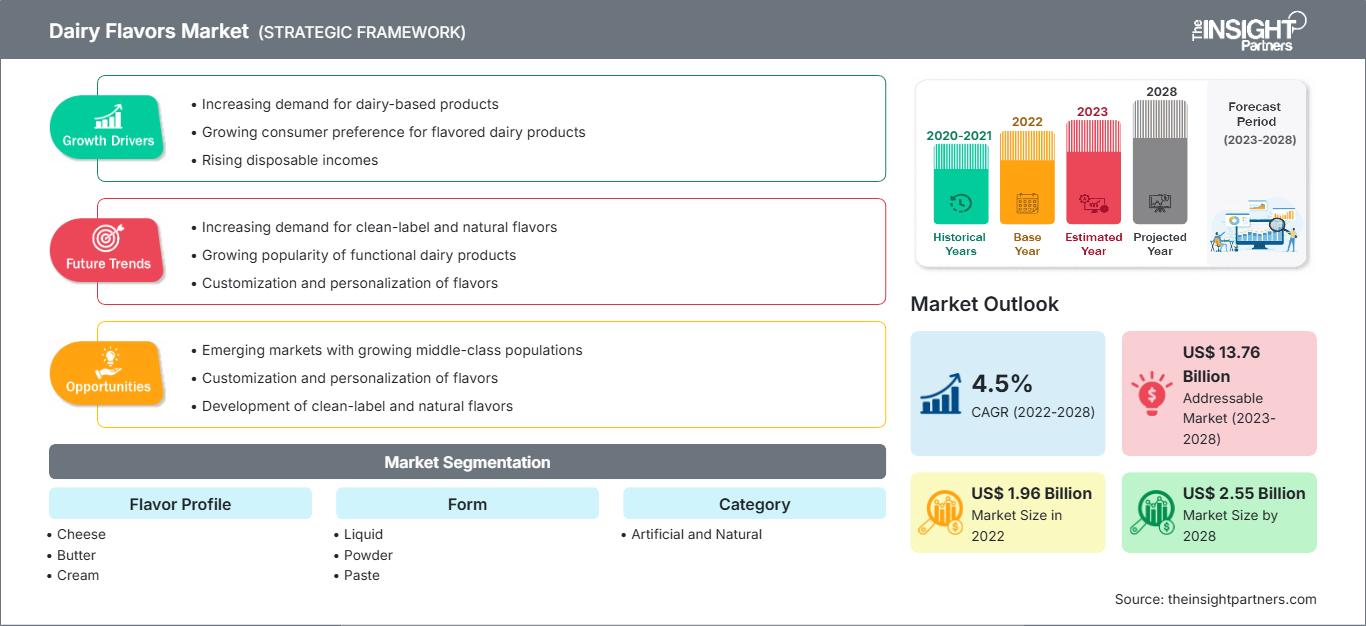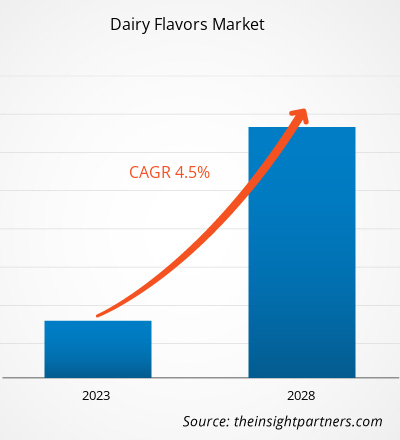Der Markt für Milcharomen soll von 1.962,45 Millionen US-Dollar im Jahr 2022 auf 2.552,19 Millionen US-Dollar im Jahr 2028 wachsen; von 2022 bis 2028 wird mit einer durchschnittlichen jährlichen Wachstumsrate von 4,5 % gerechnet.
Milcharomen sind Geschmacksstoffe, die verschiedenen Lebensmitteln und Getränken zugesetzt werden, um Milchprodukten wie Butter, Käse, Sahne und Milch ihren eigenen Geschmack zu verleihen. Milcharomen gewinnen in der Lebensmittel- und Getränkeindustrie an Bedeutung, da sie dazu beitragen, einen Milchgeschmack zu verleihen, ohne den Kalorien- oder Fettgehalt des Produkts zu erhöhen. Milcharomen werden aus Milchprodukten wie Milch, Butter, Käse und Sahne verarbeitet und hergestellt und sind in flüssiger, pulverförmiger und pastöser Form erhältlich. Diese Aromen sollen den Geschmack und die Intensität verschiedener Lebensmittel verbessern, indem sie ihnen eine Reihe von Geschmacksprofilen verleihen, beispielsweise buttrig, käsig, cremig sowie verschiedene andere süße und herzhafte Geschmacksrichtungen. Milcharomen werden in verschiedenen Lebensmitteln verwendet, beispielsweise in Back- und Süßwaren, süßen und herzhaften Snacks, Suppen und Soßen, Dips und Dressings sowie gefrorenen Desserts.
Im Jahr 2021 hatte der asiatisch-pazifische Raum den größten Anteil am Markt für Milcharomen und wird im Prognosezeitraum voraussichtlich die höchste durchschnittliche jährliche Wachstumsrate (CAGR) verzeichnen. Das Marktwachstum in dieser Region ist hauptsächlich auf das steigende Gesundheitsbewusstsein und den zunehmenden Fokus auf schmackhaftes Essen in Ländern wie Indien, China und Japan aufgrund des steigenden verfügbaren Einkommens zurückzuführen. Die Verbraucher sind in diesen Ländern bereit, höhere Preise für Milcharomaprodukte zu zahlen. Indien ist einer der am schnellsten wachsenden Märkte im asiatisch-pazifischen Raum, wo die Verbraucher keine Kompromisse bei Geschmack und Gesundheitsfaktoren der Lebensmittel eingehen möchten. Es besteht eine enorme Nachfrage nach regionalen und traditionellen Aromen vom indischen Subkontinent, was das Marktwachstum antreibt.
Passen Sie diesen Bericht Ihren Anforderungen an
Sie erhalten kostenlos Anpassungen an jedem Bericht, einschließlich Teilen dieses Berichts oder einer Analyse auf Länderebene, eines Excel-Datenpakets sowie tolle Angebote und Rabatte für Start-ups und Universitäten.
Markt für Milcharomen: Strategische Einblicke

-
Holen Sie sich die wichtigsten Markttrends aus diesem Bericht.Dieses KOSTENLOSE Beispiel umfasst Datenanalysen, die von Markttrends bis hin zu Schätzungen und Prognosen reichen.
Auswirkungen der COVID-19-Pandemie auf den Markt für Milcharomen
Vor der Pandemie waren die wachsende Nachfrage nach verarbeiteten Lebensmitteln und der zunehmende Wunsch der Verbraucher nach einer Vielfalt an Aromen und Geschmacksrichtungen die Hauptfaktoren, die das Wachstum des Marktes für Milcharomen ankurbelten. Der Markt für Milcharomen wurde von der Lebensmittel- und Getränkeindustrie angetrieben, die eine Vielzahl von Aromen in ihre Produkte integrierte. Darüber hinaus waren die Hinwendung der Verbraucher zu natürlichen Aromen und der erhöhte Konsum von verzehrfertigen Produkten in der Bevölkerung weitere Faktoren, die das Marktwachstum positiv beeinflussten. Nach dem Ausbruch der COVID-19-Pandemie im Jahr 2020 standen die Branchen jedoch vor beispiellosen Herausforderungen, darunter Lieferkettenengpässe aufgrund landesweiter Lockdowns, Handelsverbote und Reisebeschränkungen. Die Unterbrechungen der Lieferkette führten zu einem Mangel an Rohstoffen, der die Produktion und den Vertrieb verschiedener Produkte beeinträchtigte und zu höheren Preisen führte.
Im Jahr 2021 nahmen verschiedene Volkswirtschaften ihren Betrieb wieder auf, da die Regierungen mehrerer Länder die Lockerung der zuvor verhängten Beschränkungen ankündigten, was den globalen Markt ankurbelte. Darüber hinaus durften die Hersteller mit voller Kapazität arbeiten, was ihnen half, die Lücke zwischen Angebot und Nachfrage sowie andere Auswirkungen zu überwinden. Da zahlreiche Bürger vieler Länder bis 2021 vollständig geimpft waren, konzentrierten sich die Hersteller von Milcharomen darauf, ihre Produktion zu steigern, um ihre Geschäfte wiederzubeleben.
Markteinblicke
Strategische Entwicklungen wichtiger Akteure begünstigen das Wachstum des Marktes für Milcharomen
Im Juni 2020 erweiterte Edlong sein Segment für natürliche Milcharomen um eine Reihe von hochintensiven Käsesorten und kultivierten Profilen für die Verwendung in Saucen, Dressings und Dips. Im Mai 2021 erwirbt Synergy Flavors Innova Flavors von Griffith Foods Worldwide. Diese Übernahme bietet Synergy-Kunden erhebliche Vorteile, da sie Zugang zu einer bewährten Vielfalt an Aromen erhalten, um der wachsenden Nachfrage nach natürlichen Aromen und herzhaften Zutaten gerecht zu werden. Solche strategischen Entwicklungen wichtiger Marktteilnehmer dürften das Wachstum des Marktes für Milcharomen ankurbeln. Darüber hinaus verfolgen einige der wichtigsten Akteure der Region Strategien wie Fusionen und Übernahmen, um ihre geografische Präsenz auszubauen.
Einblicke in das Geschmacksprofil
Basierend auf dem Geschmacksprofil ist der Markt für Milcharomen in Käse, Butter, Sahne und andere Produkte unterteilt. Das Käsesegment hatte 2021 den größten Marktanteil und wird im Prognosezeitraum voraussichtlich die höchste durchschnittliche jährliche Wachstumsrate verzeichnen. Die Beliebtheit von Käsearomen beruht auf ihrer Verwendung unter anderem in Popcorn, Kartoffelchips, Keksen, Crackern, Dips & Brotaufstrichen sowie Soßen. Steigende Nachfrage nach Lebensmitteln, wachsende Einzelhandelsgeschäfte und eine zunehmende Vorliebe für Fast Food verstärken den Bedarf an Käsearomen.
Anwendungseinblicke
Basierend auf der Anwendung ist der Markt für Milcharomen in Back- und Süßwaren, Milch- und Tiefkühldesserts, Suppen und Soßen, Dressings, Dips und Brotaufstriche, Getränke und Sonstiges unterteilt. Brot, Kekse, Kuchen und Füllungen gehören zu den wichtigsten Back- und Süßwarenanwendungen von Milcharomen. Süßwarenhersteller verwenden in ihren Produkten zunehmend natürliche Aromen. Milchbasierte Aromen werden zunehmend in Backwaren wie Keksen und Kuchen verwendet.
Jeneil, Flavorjen, The Edlong Corporation, Givaudan SA, Kerry Group, Sensient Technologies, Symrise, Synergy Flavors, Bluegrass Ingredients Inc. und Flavorade India gehören zu den wichtigsten Akteuren auf dem Markt für Milcharomen. Diese Unternehmen konzentrieren sich hauptsächlich auf Produktinnovationen, um ihre Marktgröße zu erweitern und aufkommende Markttrends zu verfolgen.
Markt für Milcharomen
Die Analysten von The Insight Partners haben die regionalen Trends und Faktoren, die den Markt für Milcharomen im Prognosezeitraum beeinflussen, ausführlich erläutert. In diesem Abschnitt werden auch die Marktsegmente und die geografische Lage in Nordamerika, Europa, dem asiatisch-pazifischen Raum, dem Nahen Osten und Afrika sowie Süd- und Mittelamerika erörtert.Umfang des Marktberichts über Milcharomen
| Berichtsattribut | Einzelheiten |
|---|---|
| Marktgröße in 2022 | US$ 1.96 Billion |
| Marktgröße nach 2028 | US$ 2.55 Billion |
| Globale CAGR (2022 - 2028) | 4.5% |
| Historische Daten | 2020-2021 |
| Prognosezeitraum | 2023-2028 |
| Abgedeckte Segmente |
By Geschmacksprofil
|
| Abgedeckte Regionen und Länder |
Nordamerika
|
| Marktführer und wichtige Unternehmensprofile |
|
Dichte der Marktteilnehmer für Milcharomen: Verständnis ihrer Auswirkungen auf die Geschäftsdynamik
Der Markt für Milcharomen wächst rasant. Die steigende Nachfrage der Endverbraucher ist auf Faktoren wie veränderte Verbraucherpräferenzen, technologische Fortschritte und ein stärkeres Bewusstsein für die Produktvorteile zurückzuführen. Mit der steigenden Nachfrage erweitern Unternehmen ihr Angebot, entwickeln Innovationen, um den Bedürfnissen der Verbraucher gerecht zu werden, und nutzen neue Trends, was das Marktwachstum weiter ankurbelt.

- Holen Sie sich die Markt für Milcharomen Übersicht der wichtigsten Akteure
Berichts-Spotlights
- Fortschreitende Branchentrends im Markt für Milcharomen, die Unternehmen bei der Entwicklung effektiver langfristiger Strategien unterstützen
- Geschäftswachstumsstrategien der Akteure des Marktes für Milcharomen in Industrie- und Entwicklungsländern
- Quantitative Analyse des Marktes von 2022 bis 2028
- Schätzung der weltweiten Nachfrage nach Milcharomen
- Porters Fünf-Kräfte-Analyse zur Veranschaulichung der Wirksamkeit von Käufern und Lieferanten im Markt für Milcharomen
- Jüngste Entwicklungen zum Verständnis des wettbewerbsorientierten Marktszenarios
- Markttrends und -aussichten sowie Faktoren, die das Wachstum des Marktes für Milcharomen fördern und hemmen
- Unterstützung im Entscheidungsprozess durch Hervorhebung von Marktstrategien, die das kommerzielle Interesse untermauern
- Größe des Marktes für Milcharomen an verschiedenen Knotenpunkten
- Detaillierte Übersicht und Segmentierung des Marktes und der Wachstumsdynamik der Milcharomen Branche
- Größe des Marktes für Milcharomen in verschiedenen Regionen mit vielversprechenden Wachstumschancen
- Historische Analyse (2 Jahre), Basisjahr, Prognose (7 Jahre) mit CAGR
- PEST- und SWOT-Analyse
- Marktgröße Wert/Volumen – Global, Regional, Land
- Branchen- und Wettbewerbslandschaft
- Excel-Datensatz
Aktuelle Berichte
Erfahrungsberichte
Grund zum Kauf
- Fundierte Entscheidungsfindung
- Marktdynamik verstehen
- Wettbewerbsanalyse
- Kundeneinblicke
- Marktprognosen
- Risikominimierung
- Strategische Planung
- Investitionsbegründung
- Identifizierung neuer Märkte
- Verbesserung von Marketingstrategien
- Steigerung der Betriebseffizienz
- Anpassung an regulatorische Trends






















 Kostenlose Probe anfordern für - Markt für Milcharomen
Kostenlose Probe anfordern für - Markt für Milcharomen